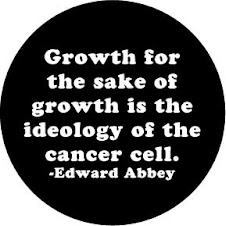In this discussion on living sustainably I have already mentioned food as a basic need. My next post will begin to look at food in more detail but for now let me wrap up this thread on corn ethanol with a move from it’s water implications to it’s impacts on food production.
Corn is Food
Of the total 93 million acres planted in corn in 2007, approximately 23 million acres were devoted to ethanol. (Food and Water Watch2007) 70 million acres of corn were used directly or indirectly for food production. The 2006 US output of ethanol was 6.5 billion gallons. (Platts 2007) The Congressional Research Service has stated:
“barring drastic realignment of US field crop production patterns, corn based ethanol’s potential as a petroleum import substitute appears to be limited by a crop area constraint.”
Tell the Bush administration because the US Dept of Energy and the US Dept of Agriculture have decided that the US has the land resources capable of producing 1.3 billion tons of biomass/yr by 2030 and that only 1 billion tons would be needed to displace 30% of the country’s oil use based on 2004 rates. Even the NRDC has gotten on board. The Natural Resources Defense Council reckons that biofuels could offset 25% of projected US transport oil consumption by 2050. (Food and Water Watch2007)
But what will be the effect on food prices? Ethanol production already has a deleterious effect on the poor who rely on the corn crop as a staple. Corn prices in Mexico rose 400% just 3 months resulting in civil unrest in Mexico in early 2007. (Jerome Taylor in “The World” 2007)
“David Pimentel,... has calculated that powering the average U.S. automobile for one year on ethanol (blended with gasoline) derived from corn would require 11 acres of farmland, the same space needed to grow a year's supply of food for seven people.” (Roger Segelken 2008)
It should be noted that Mr. Pimentel’s work on this issue has been called into question due to his research associate, Tad Patzek’s connections with the oil industry. More recent research is supporting his conclusions however.
Conclusions
The profligacy of the US extends beyond their driving habits; water use in the US is the highest in the world. According to the WWF report “Rich Countries, Poor Water”:
“In the USA, large areas are already using substantially more water than can be naturally replenished. This situation will only be further exacerbated by climate change scenarios of lower rainfall, increased evaporation and changed snow-melt patterns. Salinity threatens important irrigation areas and there is increasing anxiety over the level of contamination with chemicals and pathogens in water sources and water supplies.”
Ground and surface water pollution has resulted in an ecological catastrophe in the Gulf of Mexico and poisoned drinking water across the corn belt. The environment of the US cannot support a large scale expansion of the corn industry; indeed if anything it should be scaled back to a level that is achievable through sustainable and ecologically sound practices. There is not enough water, not enough arable land, and not enough GHG emissions reduction to be gained from an expanded corn to ethanol industry. If the subsidies currently going to support corn ethanol production, $7 billion in 2007, were instead shifted to the auto industry to help them rapidly achieve at least a doubling in CAFE standards, a much more substantive reduction in GHG emissions could be realized.
Committing to a large scale shift to corn based ethanol as a fuel for transportation in the US is a business as usual solution that threatens water quality and availability as well as making food even more unaffordable for the worlds poor. Further, cultivation of food crops for fuel means that more land will have to be converted into food crop production, whether it be rainforest, temperate wildlife habitat, or drained swampland. There is mounting evidence that this process has grave implications on GHG emissions as mature diverse wild lands tend to sequester carbon and their conversion to crop lands releases huge quantities of carbon into the atmosphere as well as methane.
I think we face a choice, would we rather eat, drink, and breath or drive an SUV?
What have you done today to lower your impact?
We are washing away the foundations of our existence on every front. It is high time we move from crashing about on the planet like a bull in china shop and find a way to go forward with intent. We must find systems of living based on sustainability. The systems and tools exist, it is up to each of us to adopt them.
Blog Archive
-
▼
2008
(188)
-
▼
February
(22)
- Video - Vesco Back from Exhaustion Part 4
- Video - Vesco Back from Exhaustion Part Two
- Food part 1 - Soil erosion - by Robb
- Video - Vesco Back from Exhaustion Part 1
- The Epiphany of Enough by Dave
- Research tidbit - Lake Mead
- Corn ethanol and Water in the US Part 5 - by Robb
- Video - Joanna Macy on The Great Turning
- The Eighth Deadly Sin by Dave
- Corn ethanol and Water in the US Part 4 - by Robb
- Corn ethanol and Water in the US Part 3 - by Robb
- Corn ethanol and Water in the US Part 2 - by Robb
- Welcome Dave; another author - by Robb
- video - Affordable Green Housing
- Corn ethanol and Water in the US Part 1 - by Robb
- Virtual Water - by Robb
- Yikes
- What's truly needed? some details - by Robb
- video - Worth Watching
- Personal Health and Basic Needs - by Robb
- Why Sustainable living? The Golden Rule - by Robb
- Sustainable living; my definition - by Robb
-
▼
February
(22)
Monday, 25 February 2008
Corn ethanol and Water in the US Part 5 - by Robb
Labels:
corn ethanol,
food,
sustainability,
water pollution
Subscribe to:
Post Comments (Atom)




.jpg)







No comments:
Post a Comment